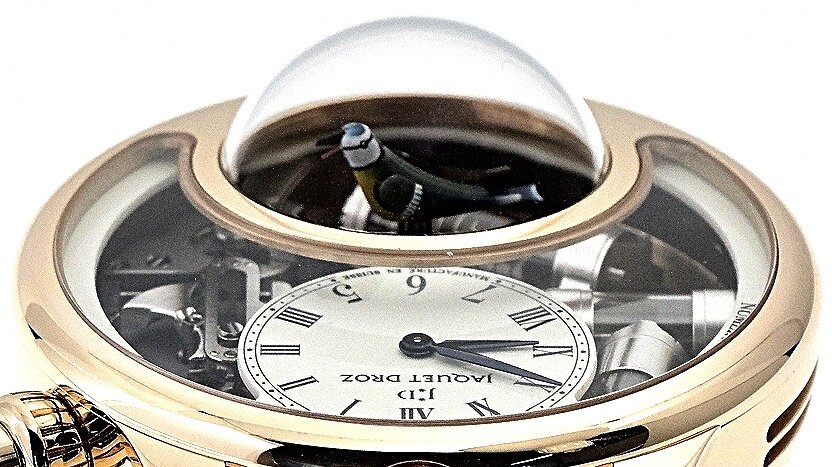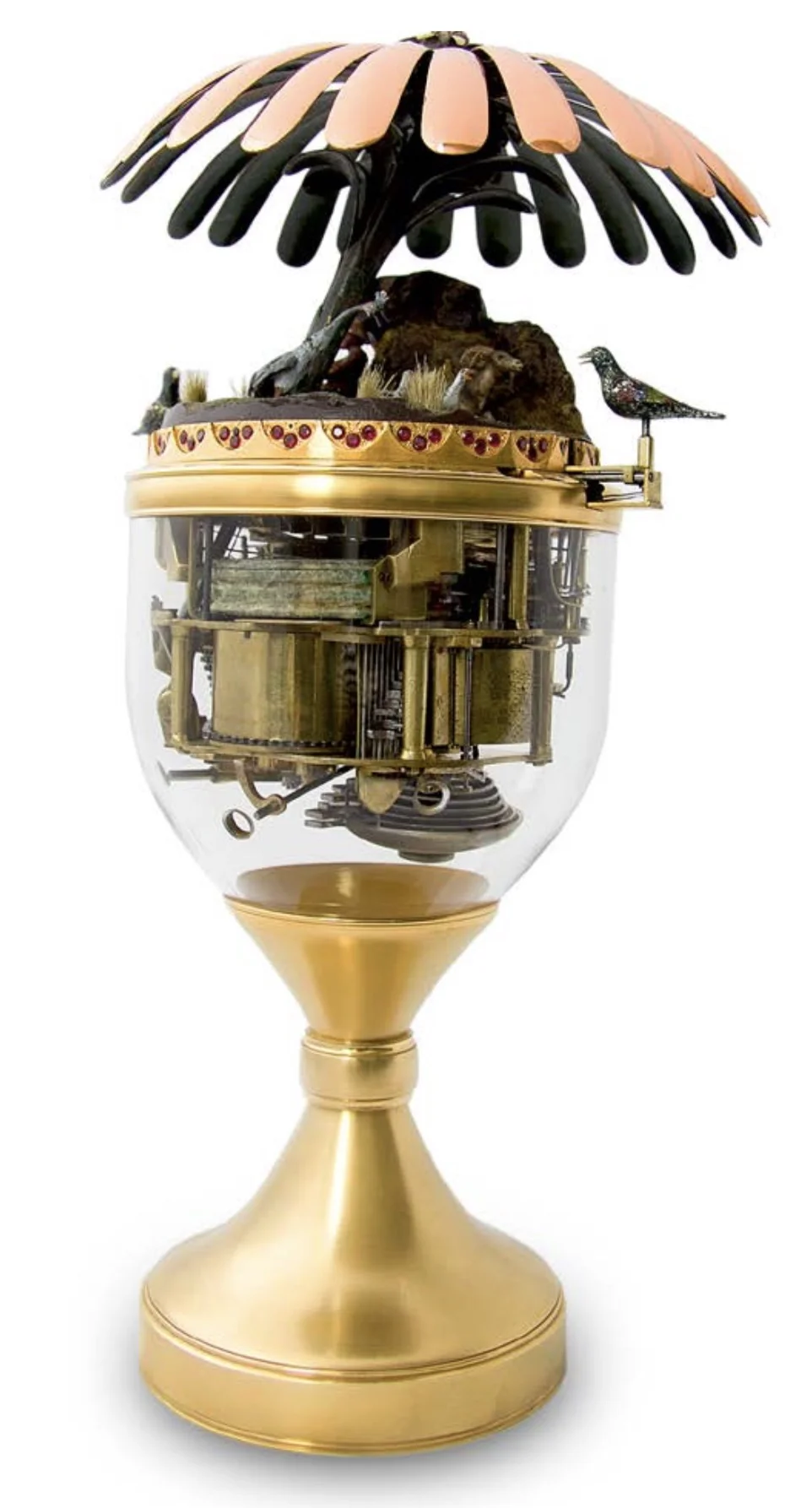Please click on an image below
A brief History
From 1738 Pierre Jaquet-Droz started working in clockmaking. He produced a series of longcase clocks and married Marianne Sandoz in 1750. Soon after the birth of his two children, Julie in 1751 and Henri-Louis in 1752, Pierre Jaquet-Droz lost his wife, followed by his daughter in 1755. He met George Keith, Earl Marischal, governor of the principality of Neuchâtel, who advised him to present his clocks abroad, in Spain where he could help introduce him to the court. With this support, Pierre Jaquet-Droz, along with his father-in-law and a young hired hand named Jacques Gevril, they built a carriage specially designed to carry six clocks and set off for Spain in 1758. They travelled for 49 days and were received in Madrid by Don Jacinto Jovert, a Spanish nobleman. After a wait of several months, Pierre Jaquet-Droz presented his clocks to King Ferdinand VI of Spain. A few days later, the clockmaker received 2,000 gold pistoles in payment for the timepieces which were purchased for the royal palaces of Madrid and Villaviciosa.
Upon his return to La Chaux-de-Fonds in 1759, the sum of money he had brought back from Spain enabled Pierre Jaquet-Droz to concentrate on making watches, clocks and automata. Assisted by his son and a neighbour’s son, Jean-Frédéric Leschot, whom he had taken in after the death of the boy’s mother and thought of as his adoptive son. This was the beginning of a close partnership. From 1773 onwards, Jaquet-Droz and Leschot perfected and marketed increasingly sophisticated automata.
Their work culminated with the three humanoid automata: The Writer, The Draughtsman and The Musician, presented in La Chaux- de-Fonds in 1774. Encouraged by this success, the Jaquet-Droz family took to the road to exhibit their products. From La Chaux- de-Fonds they travelled to Geneva and then, in 1775 to Paris where they presented the automata to Louis XVI and his queen, Marie-Antoinette. They went on to show their work at the principal courts of Europe, with visits to London, Holland and Flanders in 1780 and 1781, as well as northern France. They returned to Paris in 1782, 1783 and travelled to Lyon in 1784. The automata were also demonstrated at the Russian court in Kazan, in Madrid and beyond.
Pierre Jaquet-Droz decided to set up a workshop in London, under the management of his son, Henri-Louis. Exhausted by his travels, the latter delegated some of his responsibilities to Jean-Frédéric Leschot. Leschot was tasked in particular with overseeing the business relationship with the prominent trading company James Cox London, whose agents in Canton opened up the Far Eastern market for the Jaquet-Droz Company and for many years represented it in China, India and Japan. Pierre Jaquet-Droz always had a passion for nature and birds which he illustrated through his clocks, snuff boxes, pocket watches and automata. Over 600 pieces were exported to China in 10 years, Jaquet-Droz father and son captivated the Qianlong Emperor himself and the Mandarins at the Imperial Court, who all had an interest in European mechanical watches and automata. Several Jaquet-Droz automata and pocket watches still remain in the Imperial Palace museum today. Pierre Jaquet-Droz set up a team of watchmakers in the Neuchâtel Mountains. From 1783, management of the London operation, established in the Bartlett’s Building, was turned over to a new business partner, Henry Maillardet. The Jaquet-Droz family supervised the work of the manufacturing chain (clockmakers, engravers, jewelers, enamellers, painters and musicians) and handled the administration and the commercial side of all their businesses.
For ten years, the company continued to expand. It sold clocks, automata, watches and singing birds all over the world, primarily in China. In 1784, he decided to move to Geneva, Jean-Frédéric Leschot soon joined him and they decided to open the city’s first clockmaking manufacture, simultaneously introducing the production of timepieces featuring complications.
Jaquet-Droz was admitted to the newly reinstated Société des Arts, and was active in the advancement of technical training. Pierre Jaquet-Droz moved into the house of a clockmaker named Dental, at the corner of Rue Molard and Rue du Rhône, which housed the workshops and his son’s apartment. In 1788, the success and prosperity of Jaquet Droz & Leschot peaked, but this period was short-lived. In 1790, drafts made on their principal correspondent in China came back unpaid and their main client in London failed, putting the company in the red. The partnership with Henry Maillardet had to be liquidated. These misfortunes darkened Pierre Jaquet-Droz’s final years. He left Geneva to live in Bienne, Switzerland, where he died in 1790. His son died the following year during a trip to Naples with his wife. He was 39 years old. Due to the disastrous economic repercussions of the French Revolution in 1789 and the conflicts that arose as a result, the business, now headed by Jean-Frédéric Leschot, ran into serious financial difficulties. He continued to make snuffboxes and singing birds, but had to show great prudence: customers were notified that he now preferred to be paid cash on delivery and would no longer sell to faraway markets. The Napoleonic Wars, which pitted France against nearly every other nation of Europe, put an end to prosperity for the nobility and well-to-do bourgeoisie. The Continental Blockade, decreed by Napoleon in 1806, killed off any remaining market for luxurious objects and greatly inhibited trade with England. For Jaquet-Droz & Leschot, this was the end of a period of great creativity and prosperity.
Jaquet Droz brand joined the Swatch Group in 2000. In 2010, the company moved to its Atelier to La Chaux-de-Fonds.
Today Jaquet Droz pursues three fundamental avenues 1) "the Grande Seconde"; from the perspective of DNA this is recognisable as Jaquet Droz and differentiates itself from other brands. Today it is developed with various new complications being added. 2) Artisanal workshops that have been built internally, with enamelling, engraving, miniature painting etc. 3) Automata, such as the Charming Bird, Bird Repeater, Tropical Bird, Loving Butterfly or Lady8 Flower are constantly being developed and produced and differentiate and characterize the Jaquet Droz identity.
(The below images and the above text (an abridged version of Pierre Jaquet Droz history) are reproduced courtesy of Jaquet Droz SA).
To learn more about Jaquet Droz https://www.jaquet-droz.com/en/history






